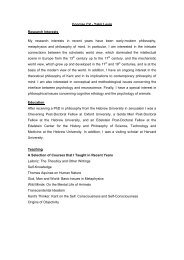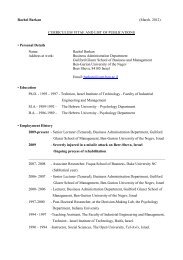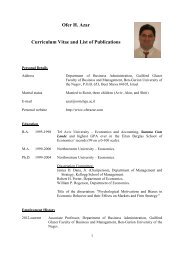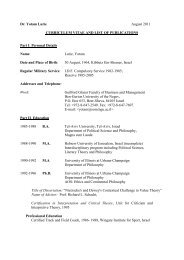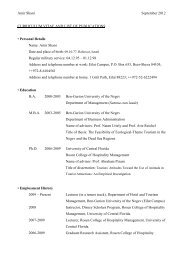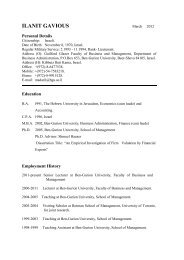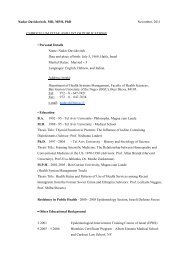Book of Abstracts
Book of Abstracts
Book of Abstracts
Create successful ePaper yourself
Turn your PDF publications into a flip-book with our unique Google optimized e-Paper software.
28<br />
Study <strong>of</strong> vulnerability <strong>of</strong> the Northern Negev agriculture to droughts with the spatially explicit model <strong>of</strong><br />
agriculture land-use dynamics<br />
Giora J Kidron, Tiferet Zilberman and Itzhak Benenson, Laboratory <strong>of</strong> Geosimulation and Spatial Analysis; Dept<br />
<strong>of</strong> Geography and Human Environment, Tel Aviv University; gkidron@post.tau.ac.il; z.tiferet@gmail.com;<br />
bennya@post.tau.ac.il<br />
Based on the data on precipitation, irrigation and wheat yield during the last 20 years in two kibbutzim in the<br />
northern Negev (Beit Kama and Mishmar HaNegev), we have developed a spatially explicit high-resolution model<br />
<strong>of</strong> crop dynamics in the northern Negev at the resolution <strong>of</strong> a single field. The dynamics <strong>of</strong> crops in the Negev is<br />
defined, primarily, by the irrigation. Based on the field data, crop cycles are estimated, separately for irrigated (e.g.,<br />
potatoes, wheat, carrot) and rain-fed fields (e.g., wheat, legumes), as an autoregression <strong>of</strong> the second or third order.<br />
The residuals <strong>of</strong> wheat are regularly used by the Bedouin herds during the critical months <strong>of</strong> the year (June-<br />
September), when the other sources <strong>of</strong> sheep food are exhausted. Bedouin husbandry, thus, critically depends on<br />
Jewish farming, and the model enables us to understand the interaction between Jews and Bedouins in the Negev.<br />
The model is calibrated based on precipitation, the irrigation network and crop data (type, yield) collected in each<br />
kibbutz during 1990- 2010. The analysis <strong>of</strong> the model for different scenarios <strong>of</strong> climatic change during 2010 ¨C<br />
2030 shows that with the employment <strong>of</strong> intensive irrigation, crop yield per hectare will drop by only half the<br />
amount in comparison to a hypothetical situation during which no irrigation would have been employed.<br />
Furthermore, the drop in crop yield may be even less substantial when the increase in wheat yield in fields that were<br />
irrigated during the previous year (during potato or carrot cultivation) is accounted for. With the increase in wheat<br />
yield (and subsequently with the increase in the residual wheat used by the Bedouins), the resilience <strong>of</strong> both<br />
communities, the Jewish and the Bedouin, increases. Yet, as the field capacity is limited and following population<br />
growth, further expansion <strong>of</strong> the Bedouin agriculture will necessitate intensive husbandry.<br />
Soil evaporation revisited – what controls evaporation dynamics from porous surfaces?<br />
Dani Or; Department <strong>of</strong> Environmental Systems Science; ETH Zurich; Zurich, Switzerland; dani.or@env.ethz.ch<br />
Evaporation dynamics from soil surfaces reflect interactions between internal liquid and vapor transport, energy<br />
input for phase change, and mass transfer across air boundary layer. The roles <strong>of</strong> two key interfaces controlling<br />
evaporation dynamics are studied: (1) interactions <strong>of</strong> wet evaporating surfaces with an air boundary layer; and (2)<br />
the role <strong>of</strong> a receding drying front. At a critical drying-front depth defined by soil pore-size distribution, capillary<br />
liquid continuity essential to supplying surface evaporation is disrupted and the evaporation rate transitions to<br />
diffusion-controlled stage-2. This characteristic length is modified by evaporation rate, hence reflecting the interplay<br />
<strong>of</strong> capillary, gravity and viscous forces. For surface-boundary layer interactions, we quantified a nonlinear behavior<br />
<strong>of</strong> drying porous surfaces responsible for enhanced vapor fluxes from remaining active pores as they become<br />
increasingly isolated (with soil surface drying). Experiments show that in contrast to nearly-constant evaporation<br />
rates at low atmospheric demand (typically



